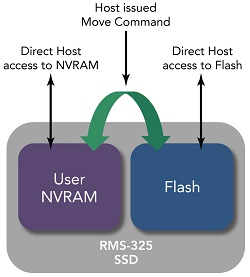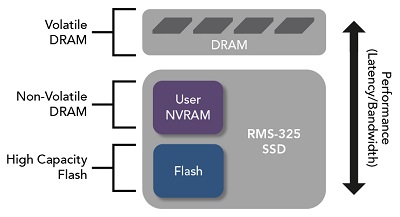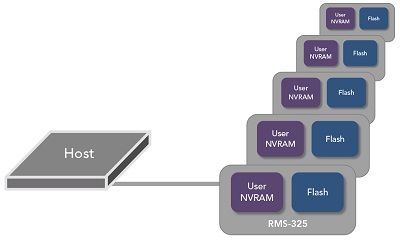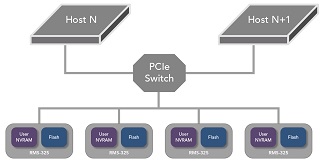Host Controlled NVRAM combined with High Capacity Flash
The User NVRAM and Flash appear as one PCIe device, but as two distinct block devices. The architecture enables the host to control:
- What data is stored in NVRAM
- What, when and where data should be transferred between NVRAM and Flash
- Issuing a single Delegated Move command that transfers data between NVRAM and Flash
- Avoids overhead of copying data over the system bus, through the host software stack, and into system memory
The NVRAM is visible as a standard block device that supports block DMA or is byte addressable via mmap PIO. With exceptional, consistent performance for small random writes and unlimited write endurance, host controlled NVRAM can minimize latency spikes and updates to Flash, improving wear out.

NVRAM/Flash Hybrid Applications:
- Coalescing and buffering writes in NVRAM, then deterministically scheduling data transfers to Flash
- Write-ahead logging and caching to NVRAM for low latency response times
- Persistent NVRAM store for metadata involving high frequency or random updates
- Ideal for efficient check pointing of NVRAM data to larger capacity Flash storage
- Device Read cache can be populated by host, with deterministic, low latency response times
Cost Effective System-Level Memory Tiering
While many FTL based SSDs include NVRAM in addition to Flash, their NVRAM can only be utilized for internal functions and is not visible to host systems. But host systems possess more intelligence about data, including how they want different data prioritized and consequently what media tier different segments should be stored upon. By providing hosts with the ability to select the media and control over transfers between the media, the RMS-325 enables a more deterministic approach to system-level memory tiering. It also enables a more balanced, efficient utilization of capacity for each tier that translates into overall cost reductions.


Scale NVRAM proportionately with Flash
Flash densities are increasing at an incredible rate, and many applications require NVRAM capacity in proportion to Flash capacity. The RMS-325 provides high densities of NVRAM, and an elegant way to scale NVRAM incrementally in proportion to additional Flash storage.
NVMe-over-Fabric, RDMA, NVMe Direct
Creating fabrics over PCIe and utilizing existing network software drivers can each be simplified and made more performant by having byte addressable memory accessible on the PCIe endpoints. The RMS-325 takes this a step further by locating the byte addressable NVRAM on the same device as the high capacity Flash storage, providing a NVMe DMA engine and the Delegated Move function.

